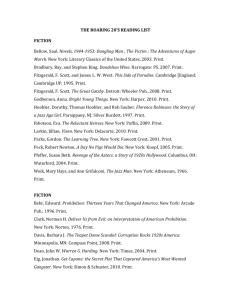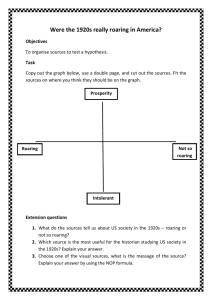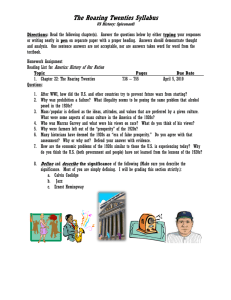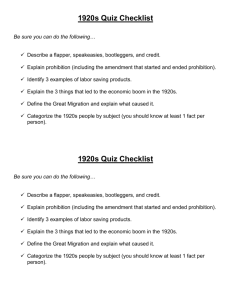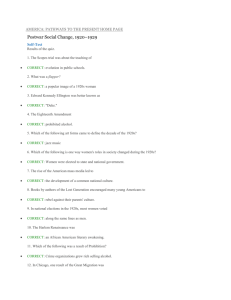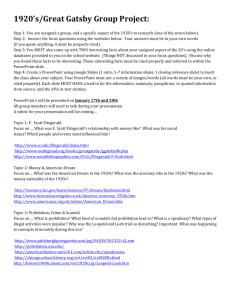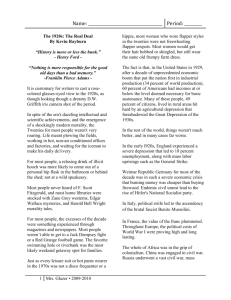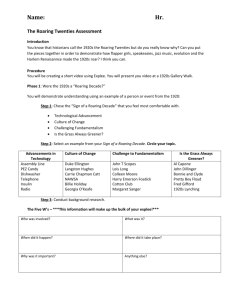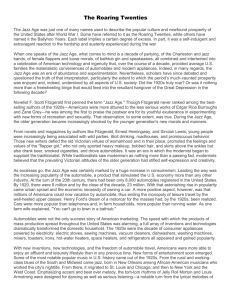The Cultural Changes of the 1920`s: Due Mon, Dec. 16th The 1920s
advertisement
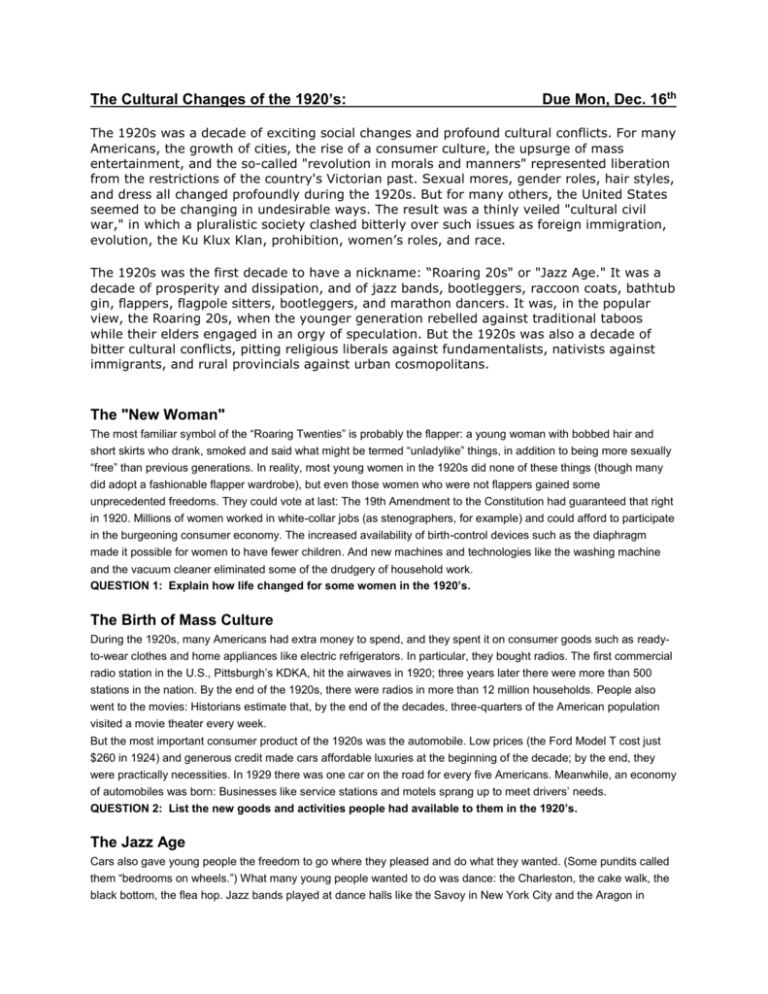
The Cultural Changes of the 1920’s: Due Mon, Dec. 16th The 1920s was a decade of exciting social changes and profound cultural conflicts. For many Americans, the growth of cities, the rise of a consumer culture, the upsurge of mass entertainment, and the so-called "revolution in morals and manners" represented liberation from the restrictions of the country's Victorian past. Sexual mores, gender roles, hair styles, and dress all changed profoundly during the 1920s. But for many others, the United States seemed to be changing in undesirable ways. The result was a thinly veiled "cultural civil war," in which a pluralistic society clashed bitterly over such issues as foreign immigration, evolution, the Ku Klux Klan, prohibition, women’s roles, and race. The 1920s was the first decade to have a nickname: “Roaring 20s" or "Jazz Age." It was a decade of prosperity and dissipation, and of jazz bands, bootleggers, raccoon coats, bathtub gin, flappers, flagpole sitters, bootleggers, and marathon dancers. It was, in the popular view, the Roaring 20s, when the younger generation rebelled against traditional taboos while their elders engaged in an orgy of speculation. But the 1920s was also a decade of bitter cultural conflicts, pitting religious liberals against fundamentalists, nativists against immigrants, and rural provincials against urban cosmopolitans. The "New Woman" The most familiar symbol of the “Roaring Twenties” is probably the flapper: a young woman with bobbed hair and short skirts who drank, smoked and said what might be termed “unladylike” things, in addition to being more sexually “free” than previous generations. In reality, most young women in the 1920s did none of these things (though many did adopt a fashionable flapper wardrobe), but even those women who were not flappers gained some unprecedented freedoms. They could vote at last: The 19th Amendment to the Constitution had guaranteed that right in 1920. Millions of women worked in white-collar jobs (as stenographers, for example) and could afford to participate in the burgeoning consumer economy. The increased availability of birth-control devices such as the diaphragm made it possible for women to have fewer children. And new machines and technologies like the washing machine and the vacuum cleaner eliminated some of the drudgery of household work. QUESTION 1: Explain how life changed for some women in the 1920’s. The Birth of Mass Culture During the 1920s, many Americans had extra money to spend, and they spent it on consumer goods such as readyto-wear clothes and home appliances like electric refrigerators. In particular, they bought radios. The first commercial radio station in the U.S., Pittsburgh’s KDKA, hit the airwaves in 1920; three years later there were more than 500 stations in the nation. By the end of the 1920s, there were radios in more than 12 million households. People also went to the movies: Historians estimate that, by the end of the decades, three-quarters of the American population visited a movie theater every week. But the most important consumer product of the 1920s was the automobile. Low prices (the Ford Model T cost just $260 in 1924) and generous credit made cars affordable luxuries at the beginning of the decade; by the end, they were practically necessities. In 1929 there was one car on the road for every five Americans. Meanwhile, an economy of automobiles was born: Businesses like service stations and motels sprang up to meet drivers’ needs. QUESTION 2: List the new goods and activities people had available to them in the 1920’s. The Jazz Age Cars also gave young people the freedom to go where they pleased and do what they wanted. (Some pundits called them “bedrooms on wheels.”) What many young people wanted to do was dance: the Charleston, the cake walk, the black bottom, the flea hop. Jazz bands played at dance halls like the Savoy in New York City and the Aragon in Chicago; radio stations and phonograph records (100 million of which were sold in 1927 alone) carried their tunes to listeners across the nation. Some older people objected to jazz music’s “vulgarity” and “depravity” (and the “moral disasters” it supposedly inspired), but many in the younger generation loved the freedom they felt on the dance floor. QUESTION 3: Look up and then list some artists and dances associated with the Jazz Age. Prohibition During the 1920s, some freedoms were expanded while others were curtailed. The 18th Amendment to the Constitution, ratified in 1919, had banned the manufacture and sale of “intoxicating liquors,” and at 12 A.M. on January 16, 1920, the federal Volstead Act closed every tavern, bar and saloon in the United States. From then on, it was illegal to sell any “intoxication beverages” with more than 0.5% alcohol. This drove the liquor trade underground– now, people simply went to nominally illegal speakeasies instead of ordinary bars–where it was controlled by bootleggers, racketeers and other organized-crime figures such as Chicago gangster Al Capone. (Capone reportedly had 1,000 gunmen and half of Chicago’s police force on his payroll.) To many middle-class white Americans, Prohibition was a way to assert some control over the unruly immigrant masses who crowded the nation’s cities. For instance, to the so-called “Drys,” beer was known as “Kaiser brew.” Drinking was a symbol of all they disliked about the modern city, and eliminating alcohol would, they believed, turn back the clock to an earlier and more comfortable time. QUESTION 4: What law made the US “dry”? How did Prohibition backfire? The "Cultural Civil War" Prohibition was not the only source of social tension during the 1920s. The Great Migration of African Americans from the Southern countryside to Northern cities and the increasing visibility of black culture—jazz and blues music, for example, and the literary movement known as the Harlem Renaissance—discomfited some white Americans. Millions of people in places like Indiana and Illinois joined the Ku Klux Klan in the 1920s. To them, the Klan represented a return to all the “values” that the fast-paced, city-slicker Roaring Twenties were trampling. Likewise, an anti-Communist “Red Scare” in 1919 and 1920 encouraged a widespread nativist, or anti-immigrant, hysteria. This led to the passage of an extremely restrictive immigration law, the National Origins Act of 1924, which set immigration quotas that excluded some people (Eastern Europeans and Asians) in favor of others (Northern Europeans and people from Great Britain, for example). These conflicts–what one historian has called a “cultural Civil War” between city-dwellers and small-town residents, Protestants and Catholics, blacks and whites, “New Women” and advocates of old-fashioned family values–are perhaps the most important part of the story of the Roaring Twenties. QUESTIONS 5-8: What is the Harlem Renaissance? Why does the KKK expand? What is the “Red Scare” and what does it lead to? Also look up the Scopes Monkey Trial and explain what that is and why it is important.



